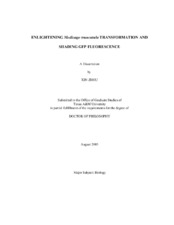| dc.description.abstract | Medicago truncatula (M. truncatula) has been proposed as a model legume for
molecular and genetic studies of legumes. While many genetic resources have been
developed for this model legume, genetic transformation of the M. truncatula line A17
proved to be a problem. A reproducible transformation method is described for M.
truncatula A17. Procedures are detailed that yielded an average regeneration frequency
of 35% for recovery of transgenic shoots from cotyledonary node explants. Previously,
rooting of transgenic shoots of this line has proven difficult, but media and culture
procedures are described that yielded an average frequency of 39% for root induction
from 419 phosphinothricin-resistant shoots. Fertile M. truncatula A17 plants transgenic
for 35S-GFP, phas-GUS or phas-GFP were obtained. The presence of transgenes was
confirmed by expression of transgenes and by genomic DNA blots. Interestingly,
although GUS and GFP driven by the phas promoter were very strongly and uniformly
expressed in seed cotyledons of most transgenic M. truncatula lines, silencing of the
GUS expression from the phas promoter was observed in several lines, indicating the occurrence of novel epigenetic events.
The diminution of GFP fluorescence in transgenic M. truncatula occurs despite
the presence of GFP transcript and protein. To evaluate the generality and causes of this
phenomenon, fluorescence during leaf development from the same 35S-GFP transgene
was compared in M. truncatula, rice and Arabidopsis. A substantial decrease in
fluorescence early in the development of M. truncatula and rice leaves was found to
correlate with chlorophyll accumulation. Several approaches showed that chlorophyll is
causally involved in the loss of GFP fluorescence. Removal of chlorophyll from leaves
of transgenic M. truncatula, rice or Arabidopsis through etiolation or by extraction with
ethanol yielded up to a tenfold increase in fluorescence. Direct evidence that chlorophyll
is implicated in the loss of fluorescence from GFP was obtained by mixing solutions of
chlorophyll and GFP. At low concentration, fluorescence loss was fourfold greater for
chlorophyll b than for chlorophyll a, reflecting their relative interference with GFP
excitation and emission. Thus, substantial errors in estimating promoter activity from
GFP fluorescence can occur if pigment interference is not considered. | en |


